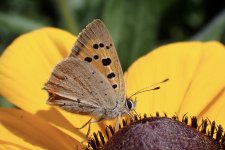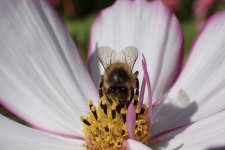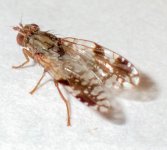-
Welcome to BirdForum, the internet's largest birding community with thousands of members from all over the world. The forums are dedicated to wild birds, birding, binoculars and equipment and all that goes with it.
Please register for an account to take part in the discussions in the forum, post your pictures in the gallery and more.
You are using an out of date browser. It may not display this or other websites correctly.
You should upgrade or use an alternative browser.
You should upgrade or use an alternative browser.
Compact camera for Macro. (1 Viewer)
- Thread starter Pepitogrillo
- Start date
More options
Who Replied?
I think the old wet film definition of macro, size on negative larger than actual, doesn't really have much utility in the world of digital. The TG-6 might not be macro by the wet film definition but for most folk who just want to take close up photos of invertebrates it is a fine solution.
I'm not saying the TG6 doesn't look impressive for a compact (I'm tempted myself, mainly for the inbuilt focus stacking), but I don't understand why the magnification ratio matters less in digital?
From a review:
As I mentioned before, the TG-6 really excels with subjects that are close up. Its up-close focus distance is incredible – subjects need to be just 1 cm from the lens.
Some reviewers even claim they’ve had the subject literally touching the lens and still were able to focus. That wasn’t my experience… I usually needed a bit more than 1 cm, but still, that’s downright amazing.
To use that focal distance, you’ll need to use the TG-6’s microscope mode. This is an optical zoom mode with an image magnification of 7x (35mm equivalent).
Tbh the 7x time seems a bit high to me.
I really don't get the idea that 1cm focusing is an advantage? surely it's better to have the same magnification area from something like 30cm so that you're not blocking as much light/relying on flash or disturbing the subject? Again I'm not saying that the close focus results aren't impressive for such a small sensor - I've not seen better from a compact.
Musoman
PETE - Nikon/Sony Shooter

They are really impressive for such a camera. But i dont see the likeness with true macro lenses.
EG
A European Mantis i shot in Crete ( landed on the sofa of all places ) - it's about 2.5 / 2.7 inches overall, and this photo below of it's eye was on a 60mm Nikon macro.
Next is a UK Bush Cricket i shot , also 2.5/2.7 inches and again, they eye shot was taken with a Tamron SP 90mm macro.
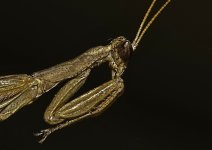
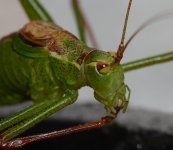
EG
A European Mantis i shot in Crete ( landed on the sofa of all places ) - it's about 2.5 / 2.7 inches overall, and this photo below of it's eye was on a 60mm Nikon macro.
Next is a UK Bush Cricket i shot , also 2.5/2.7 inches and again, they eye shot was taken with a Tamron SP 90mm macro.


pdwinter
Paul Winter
The UK Bush Cricket is a male Speckled Bush-cricket which has a length of 9-17mm - not sure what the 2.5/2.7 inches refers to.Next is a UK Bush Cricket i shot , also 2.5/2.7 inches and again, they eye shot was taken with a Tamron SP 90mm macro.
Leaving that aside, as far as I can tell no one here us arguing that a compact camera can get you shots as detailed as a DSLR / Mirrorless with a true macro lens.
What some of us have been trying to do is answer the question in the OP (as below)
Personally, I use Canon mirrorless (RP and R10) with a Canon 100mm macro lens to get good quality photos of smallish insects (for presentations) but I also carry an Olympus TG-6 and have got perfectly acceptable images for ID / small web presentations from that. I also have a Canon HS60 SX but, probably because (a) I haven't persevered and (b) I really bought the camera for record shots of distant birds, I've not managed to get many good closeup pictures.Hello,
I'm Looking information on one Compact Camera for Macro photo, anyone know some on this theme?
Thank you
PG.
If I was starting out now, and having seen some brilliant insect pictures using the Olympus OM-1 coupled with the 60mm macro lens, then I would probably buy that combination.
But Pepitogrillo wants to know about Compact cameras!
Musoman
PETE - Nikon/Sony Shooter

Yes, you're right. I posted the size for the Great Green by mistake. In fact it's even smaller than i originally thought.The UK Bush Cricket is a male Speckled Bush-cricket which has a length of 9-17mm - not sure what the 2.5/2.7 inches refers to.
10-20mm for The Speckled
If the OP is only interested in a compact, that TG6 would be ideal
Yes, the title of the thread is "compact camera for macro," so that is what I take the subject of the thread to be--what compact gives you the best macro shots? Full-sized macro setups with flash and diffuser can be pretty cumbersome, so there may be lots of situations where photographers want something more compact.If the OP is only interested in a compact, that TG6 would be ideal
However, the TG6 strikes me as far from "ideal." I have the TG4 which, though older, is very similar to the TG6. The sensor is small and the image quality is so so, and there is no full manual mode. Even in aperture priority mode you only get to select from three different aperture settings; there is no shutter priority mode. But it does appear to have the best in class magnification power – having both a microscope and super microscope mode. So if you are photographing really small stuff, e.g. springtails, then it may be your best option. (I tried a few springtail shots and they were only half decent – I never got the full critter in sharp focus even with bracketing--though the camera usually selected an f4.9 aperture).
But what if you are going to be focusing on larger subjects, e.g. 1 cm or larger? In that event high magnification is less of a priority, and other compacts with larger sensors and better image quality might yield better results even if they offer less magnification. So I don't see the TG6 as the end of the discussion. There are a variety of larger sensor compacts available.
Steve Babbs
Well-known member
Yes. There's no doubt a dedicated macro lens and the right body will get better pictures. But as far as I am aware these are the only compact cameras which will take true macro shots. Personally I'm waiting for the 90mm Olympus macro.Leaving that aside, as far as I can tell no one here us arguing that a compact camera can get you shots as detailed as a DSLR / Mirrorless with a true macro lens.
What some of us have been trying to do is answer the question in the OP (as below)
But Pepitogrillo wants to know about Compact cameras!
Last edited:
I bought a TG6 for diving, the waterproofing of the camera gives a bit of confidence in case of a leaking housing and the macro performance is very pleasing.
when I received the camera I visited Batemans, home of Rudyard Kipling and took some macro shots of insects and plants.
As a compact with macro ability I found it excellent, just slip it out of one’s pocket, point and shoot.
when I received the camera I visited Batemans, home of Rudyard Kipling and took some macro shots of insects and plants.
As a compact with macro ability I found it excellent, just slip it out of one’s pocket, point and shoot.
Attachments

Something like a Canon EOS M200 with the 28mm EF-M macro is not that much larger than a Sony RX100, and far superior in image quality. It even goes better than 1:1 at 1:1.2 magnification, and has a built-in macro ring light.
Compact Camera Meter
Compare unlimited number of cameras with lenses, see how compact or bulky a camera is and sort by height, width, depth and weight.
camerasize.com
Surreybirder
Ken Noble
I recently got the TG-6 and am still trying to get to grips with it. But I've been using the SX40 for some years and all I can say is that it is not a patch on the TG-6 for macro, although I am sure the HS60 is better.Personally, I use Canon mirrorless (RP and R10) with a Canon 100mm macro lens to get good quality photos of smallish insects (for presentations) but I also carry an Olympus TG-6 and have got perfectly acceptable images for ID / small web presentations from that. I also have a Canon HS60 SX but, probably because (a) I haven't persevered and (b) I really bought the camera for record shots of distant birds, I've not managed to get many good closeup pictures.
One of the great features of the TG-6 is that you can do 'stacking' which effectively extends the depth of field. I'm still learning the best way of doing this - and the poor natural light lately hasn't helped. But it definitely has potential.
One question: for macro which is most useful in the field, the flash diffuser or the LED ring light attachment? (I cannot afford both!)
Shot of live fly below (TG-6). This is an example of where stacking would have helped.
Attachments
Surreybirder
Ken Noble
I had a look in the manual, which isn't the easiest to follow. It saidNot tried the stacking. I found that the LED ring attachment kept turning itself off after a short interval which resulted in me having to fanny about in the field too much so I use the flash diffuser instead. But it may be that I need to read the manual about the LED ring.
Using the LED illuminator
Unlike the fl ash, which lights only briefl y, the LED illuminator stays lit for longer periods.
It can also serve as a fl ashlight.
1 Press and hold the INFO button.
2 Release the button when the LED illuminator
lights.
• The illuminator will light even if the camera is off.
LED illuminator
If the camera is on
The LED illuminator will remain lit for up to around 90 seconds while camera controls
are in use, or up to 30 seconds if no operations are performed.
• The LED illuminator can be used during movie recording. It cannot, however, be used to
fi lm 4K movies.
If the camera is off
The LED illuminator will remain lit for up to around 30 seconds, whether or not you
attempt to operate camera controls.
• The LED illuminator turns off automatically if you:
• press the ON/OFF button,
• use the LOG switch,
• display the menus,
• connect or disconnect a USB cable, or
• connect to a Wi-Fi network.
To turn the LED illuminator off
Press and hold the INFO button down until the LED illuminator turns off.
pdwinter
Paul Winter
Apologies for delay in replying - my phone didn't work very well with Birdforum while I was away!
Thanks for listing that bit of the manual. I now remember what made me stop using the LED ring.
If you turn it on but the insect you are trying to photograph moves so you have to reposition yourself it's very easy for 30 seconds to go by without you touching any buttons by which time the LED ring has turned itself off. So I was regularly turning the camera over to check if the LED ring was on or off and as a consequence missing shots.
With the flash diffuser it will always be on (if you have the flash set to on) and you just get the burst of flash when you need it. You can also adjust the amount of diffusion.
Thanks for listing that bit of the manual. I now remember what made me stop using the LED ring.
If you turn it on but the insect you are trying to photograph moves so you have to reposition yourself it's very easy for 30 seconds to go by without you touching any buttons by which time the LED ring has turned itself off. So I was regularly turning the camera over to check if the LED ring was on or off and as a consequence missing shots.
With the flash diffuser it will always be on (if you have the flash set to on) and you just get the burst of flash when you need it. You can also adjust the amount of diffusion.
Users who are viewing this thread
Total: 2 (members: 0, guests: 2)





